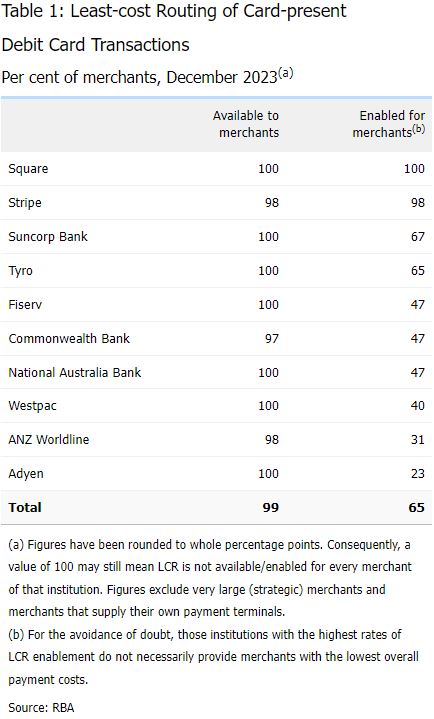Impact of Card Surcharge Regulations in Australia
Card surcharge regulations in Australia have a significant impact on consumers and businesses. Australians are currently losing close to a billion dollars annually in card surcharges, which could be substantially reduced through the proper implementation of least-cost routing.
Least-cost routing (LCR) is a scheme introduced by the Reserve Bank with the goal of reducing card payment processing fees for businesses and ensuring that these savings are passed on to consumers. Failure to meet the target of 80% uptake of LCR by the middle of the year may lead to RBA governor Michele Bullock mandating its implementation in the industry.
Many Australians, like Alex, prefer using cards over cash for their daily transactions. However, the surcharges associated with card payments can quickly add up. For instance, Alex paid 21 cents in surcharges for a simple lunch, and these fees continue to accumulate with each transaction.
According to Alex, who works as an IT professional in Melbourne, these surcharges can amount to around $200 annually. This financial burden is particularly significant for individuals like Alex, who are mindful of every dollar spent, especially considering other financial commitments such as home loans.
An analysis based on data from the RBA indicates that Australians collectively lose a staggering $960.26 million each year due to card surcharges, highlighting the pressing need for effective regulations and the widespread adoption of cost-saving measures like LCR.

In Australia, the frequency of card payments surpasses that of numerous similar economies, as reported by ABC News’ Sean Warren.
Challenges Faced by Consumers with Card Surcharge Regulations in Australia
The Future of Cash: Insights on Card Surcharge Regulations in Australia

In Australia, there are specific regulations regarding card surcharges that businesses must adhere to. These guidelines aim to ensure fair and transparent practices when it comes to charging customers for using cards. It is essential for businesses to understand and comply with the card surcharge regulations in Australia to avoid any potential penalties or fines. By following these rules, businesses can maintain trust with their customers and operate ethically within the legal framework.
Challenges Faced by Small Businesses in Dealing with Card Surcharge Regulations in Australia
Navigating card surcharge regulations in Australia can be perplexing. Opting for tap-and-go convenience may come at a higher cost due to surcharges.
In Australia, debit cards, the most commonly used payment method, often come as dual-network cards. These cards bear a Mastercard or Visa logo on the front and an eftpos logo on the back.
When using a dual-network card, selecting the eftpos network by inserting or swiping the card on the terminal can save you money. Conversely, tapping the card will automatically route the transaction through the pricier Mastercard or Visa network.
Unlike larger corporations such as department stores and supermarkets that absorb payment costs without passing on surcharges to customers, small businesses are compelled to transfer these expenses to consumers.
Unfortunately, many small businesses in Australia are grappling with the financial strain caused by inflation and escalating costs, exacerbated by the burden of card surcharge regulations.

Using the keyphrase “card surcharge regulations Australia,” Luke Achterstraat, the CEO of the Council of Small Business Organisations Australia (COSBOA), emphasized the crucial need for support for small businesses during these challenging times. According to Achterstraat, small businesses in Australia, totaling 2.5 million, are currently facing a significant cost of doing business crisis. These businesses are finding it extremely difficult to merely break even, let alone generate a profit.
Card Surcharge Regulations in Australia: A Cost-Effective Payment Option, Yet Slow Adoption
As per a report by the RBA, businesses incur an average cost of 30 cents for a $100 purchase, equivalent to 0.3 per cent, for eftpos transactions. Conversely, Visa and Mastercard debit transactions average at 0.5 per cent.
Credit card transactions through Mastercard and Visa come at a cost of 0.9 per cent. On the other hand, American Express and Diners Club cards stand as the priciest networks, with an average cost of approximately 1.3 per cent and 1.7 per cent, respectively.
In a bid to reduce card processing expenses for businesses, subsequently enabling them to transfer the cost benefits to consumers, the Reserve Bank has rolled out an initiative known as least-cost routing (LCR). This initiative ensures that business terminals automatically opt for the most economical card network to handle their debit transactions.

The RBA expressed disappointment over the low adoption of LCR among merchants in Australia. According to the RBA, the implementation of LCR should ideally lead to reduced payment costs, resulting in smaller card surcharge regulations for consumers. However, currently, only 64% of business terminals support LCR, which the RBA deems as progressing at a sluggish pace.
Analysts in the payment industry attribute the delay in widespread LCR adoption to banks, as they generate higher profits from Mastercard and Visa compared to eftpos transactions. Brad Kelly, the managing director of Payment Services, a payments consultancy, explained that banks lack the financial incentive to prioritize least-cost routing. Consequently, they are hesitant to fully embrace LCR until compelled to do so by regulatory measures in Australia.
Banks Criticized for Taking Advantage of the Discrepancy
According to Mr. Kelly, banks and payment providers are being accused of overcharging merchants through a uniform fee structure, despite the varying processing costs for different payment methods.

**The Lack of Incentive for Banks to Enable Least-Cost Routing in Australia**
**Card Surcharge Regulations Australia: A Closer Look**
In a recent statement, Brad Kelly highlighted that banks in Australia lack the motivation to implement least-cost routing. According to Kelly, banks are capitalizing on the unique low-cost debit network in Australia known as eftpos, which competes with major players like Visa and Mastercard. By inflating the fees on eftpos transactions by up to 1.5 or 2 percent, banks are effectively subsidizing the more expensive payment networks, resulting in a significant cross-subsidy. This practice, as Kelly points out, is detrimental to both merchants and consumers, costing them well over a billion dollars collectively.
The major banks in Australia, including the big four, offer flat rates ranging from 1.1 percent to 1.4 percent. While Australian payment service provider Tyro charges 1.4 percent, the global giant Square charges slightly higher at 1.6 percent. The banking sector defends these flat rates by arguing that some businesses prefer the certainty they provide, asserting that the choice of least-cost routing ultimately lies with the businesses themselves.
Anna Bligh, the CEO of the Australian Banking Association, emphasized the importance of businesses making informed choices regarding payment processing fees. She noted a significant 13 percent decrease in bank fees and charges over the past year, with a consistent downward trend over the last decade. Bligh encouraged businesses looking to reduce their fees to consider implementing least-cost routing, highlighting that this option is readily available from all banks.
When approached for comments, various financial institutions provided insights into their pricing strategies. The Commonwealth Bank defended its flat rate of 1.1 percent as the “lowest in the market,” positioning it as a simplified pricing option. ANZ Worldline reiterated its commitment to prioritizing least-cost routing for its merchants, while NAB acknowledged that this may not always be the most cost-effective choice for every small business. Square emphasized the simplicity and transparency of its pricing structure, which includes additional services beyond payment processing. Tyro revealed that least-cost routing is automatically enabled for new merchants, with the majority opting against a flat fee model.
In conclusion, the debate surrounding card surcharge regulations in Australia underscores the complex interplay between banks, merchants, and consumers. While banks may not have a direct incentive to promote least-cost routing, the push for transparency and cost-effectiveness in payment processing remains a crucial issue for all stakeholders involved. By empowering businesses to make informed decisions and offering competitive pricing options, the financial industry can work towards a more equitable and efficient payment ecosystem in Australia.
The RBA’s Warning on Potential Mandate of LCR
The Reserve Bank of Australia (RBA) governor, Michele Bullock, has issued a warning regarding the potential mandate of Liquidity Coverage Ratio (LCR) regulations in the country. Bullock emphasized that if the industry fails to achieve the target of 80 per cent by the middle of the year, the RBA may enforce LCR regulations.

Michele Bullock has highlighted that the payments industry must increase merchant adoption by June 2024 to avoid regulatory repercussions. The small business community views this directive positively, anticipating benefits for both businesses and consumers. According to Mr. Achterstraat, a Tasmanian small business reported savings exceeding $100,000 annually through the scheme, emphasizing its significant cost-saving potential in today’s high-cost business environment. Encouraging payment providers and banks to actively promote and simplify the opt-in process for least-cost routing is crucial for widespread adoption.
Contrary to this perspective, Ms. Bligh expressed skepticism towards a mandated approach, deeming it overly simplistic. She emphasized that businesses consider various factors when selecting a payment package, with merchant fees being just one component alongside terminal rental costs and other services. While acknowledging the growth potential in least-cost routing, Ms. Bligh believes that achieving 100% voluntary compliance may be unattainable due to businesses prioritizing certain package features over slight fee reductions.
For more insights, tune in to The Business tonight at 8:45 pm AEST on ABC News Channel or stream on ABC iview.




